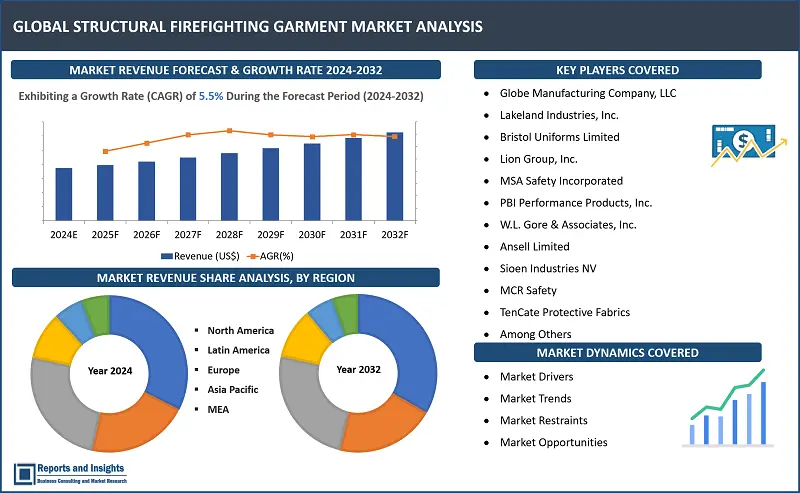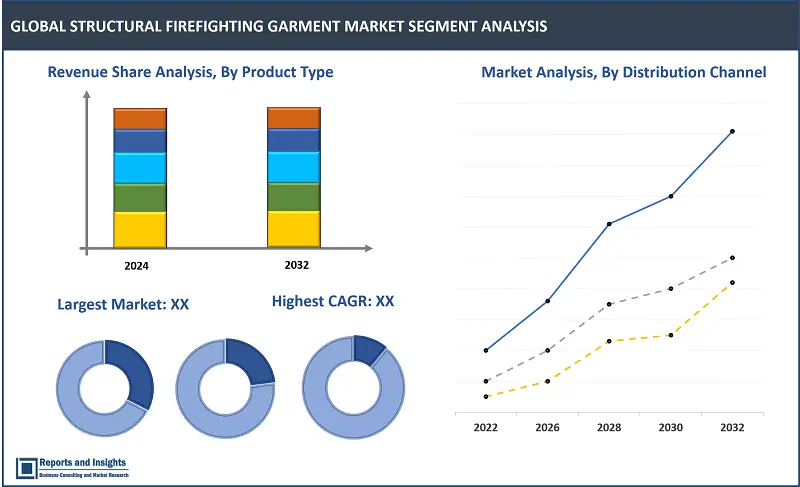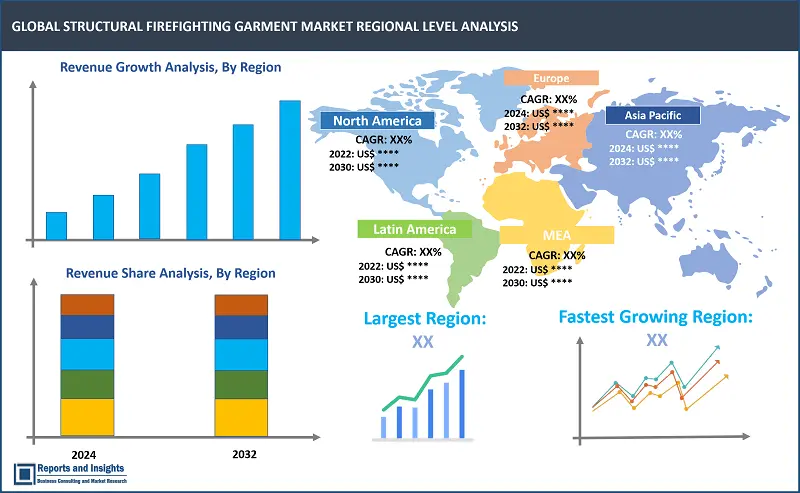Market Overview:
"The global structural firefighting garment market size reached US$ 2,238.7 million in 2023. Looking forward, Reports and Insights expects the market to reach US$ 3,624.7 million in 2032, exhibiting a growth rate (CAGR) of 5.5% during 2024-2032."
|
Report Attributes |
Details |
|
Base Year |
2023 |
|
Forecast Years |
2024-2032 |
|
Historical Years |
2021-2023 |
|
Market Growth Rate (2024-2032) |
5.5% |
The global structural firefighting garment market is registering significant revenue growth due to increasing safety concerns and stringent regulations in the firefighting industry. Factors such as rising incidents of fire accidents, advancements in firefighter safety equipment, and the growing awareness about the importance of Personal Protective Equipment (PPE) are driving market growth.
Also, use of innovative materials and technologies in firefighting garments, such as heat and flame-resistant fabrics and moisture-wicking properties, is expected to support revenue growth of the market. Customization and ergonomic designs to enhance firefighter comfort and mobility is among other trends observed in the global market.

Structural Firefighting Garment Market Trends and Drivers:
Increasing Fire Incidents: Increase in number of accidents globally has created rising demand for structural firefighting garments. Fire incidents, both in residential and commercial settings, has been increasing substantially in the past decade, and the need for more advanced protective clothing and solutions has been rising in parallel.
Stringent Safety Regulations: Governments and regulatory bodies have imposed strict safety regulations, mandating the use of certified firefighting garments. This has led to increased adoption of high-quality, compliant garments, and is driving market growth.
Technological Advancements: The market is witnessing continuous technological advancements in structural firefighting garments. Innovations such as moisture-wicking fabrics, enhanced thermal protection, and integrated communication systems have improved the overall performance and safety of firefighters, leading to steady market growth.
Focus on Firefighter Safety: There is a growing emphasis on firefighter safety and well-being, leading to the demand for ergonomically designed garments that provide enhanced mobility and comfort. Firefighters' preferences for lightweight, breathable, and flexible garments have influenced the market trends.
Market Expansion in Developing Regions: The market is experiencing significant growth in developing regions such as Asia Pacific and Latin America. Rapid urbanization, industrialization, and infrastructure development projects have increased the demand for firefighting garments, driving market revenue growth in these regions.
Structural Firefighting Garment Market Restraints:
High Cost: Structural firefighting garments often come with a high price tag due to the use of advanced materials and technologies. This can pose a challenge for budget-constrained fire departments and organizations, limiting their ability to invest in these garments.
Limited Awareness and Adoption: In some regions, there may be limited awareness about the importance of structural firefighting garments or inadequate training on their usage. This can hinder the widespread adoption of these garments and negatively impact market growth.
Complex Maintenance Requirements: Structural firefighting garments require proper maintenance and regular inspection to ensure their effectiveness and longevity. The complexity of maintenance procedures, including cleaning, decontamination, and repairs, can be a deterrent for some organizations, leading to suboptimal usage or delays in garment replacements.
Weight and Mobility Concerns: Firefighters often face challenges related to the weight and mobility restrictions imposed by structural firefighting garments. The bulkiness and limited flexibility of these garments can hinder their movement and agility, impacting their effectiveness during firefighting operations.
Environmental and Health Concerns: The use of certain materials and chemical treatments in firefighting garments may raise environmental and health concerns. Fire departments and organizations are increasingly focusing on eco-friendly and sustainable solutions, which can pose challenges for traditional garment manufacturers in meeting these requirements.
Structural Firefighting Garment Market Opportunities:
Technological Advancements: The advancement of technology presents opportunities for the structural firefighting garment market. Innovative materials, such as lightweight and heat-resistant fabrics, are being developed, offering improved comfort and safety for firefighters. Additionally, the integration of smart technologies, such as built-in sensors and communication systems, can enhance situational awareness and communication capabilities.
Growing Awareness and Safety Regulations: Increasing awareness about the importance of firefighter safety and the implementation of stringent safety regulations by governing bodies create opportunities for the market. Fire departments and organizations are prioritizing the procurement of high-quality structural firefighting garments to ensure the safety and well-being of their firefighters.
Emerging Markets: The growth of the construction industry and urbanization in emerging markets present significant opportunities for the structural firefighting garment market. As infrastructure development increases, the demand for effective firefighting gear also rises, creating new revenue streams in these regions.
Product Customization and Tailoring: The demand for customized and tailor-made structural firefighting garments is increasing. Manufacturers that can provide personalized solutions to meet specific requirements, such as fitting, functionality, and design, can capitalize on this trend and gain a competitive edge.
Collaboration and Partnerships: Collaborations between manufacturers, fire departments, and research institutions can drive innovation and product development in the structural firefighting garment market. Partnerships that focus on addressing challenges, such as weight reduction, mobility enhancement, and environmental sustainability, can lead to the development of advanced garments and open new revenue streams.
Structural Firefighting Garment Market Segmentation:

By Product Type:
- Coats
- Trousers/Pants
- Coveralls
- Helmets
- Gloves
- Boots
- Others
By Material Type:
- Nomex
- PBI (Polybenzimidazole)
- Kevlar
- Gore-Tex
- Others
By End Use:
- Fire Departments
- Defense & Military
- Oil & Gas
- Chemical & Petrochemical
- Manufacturing
- Construction
- Others
By Distribution Channel:
- Direct Sales
- Distributors
- Online Retailers
- Specialty Stores
By Region:

North America:
- United States
- Canada
Europe:
- Germany
- United Kingdom
- France
- Italy
- Spain
- Russia
- Poland
- BENELUX
- NORDIC
- Rest of Europe
Asia Pacific:
- China
- Japan
- India
- South Korea
- ASEAN
- Australia & New Zealand
- Rest of Asia Pacific
Latin America:
- Brazil
- Mexico
- Argentina
- Rest of Latin America
Middle East & Africa:
- Saudi Arabia
- South Africa
- United Arab Emirates
- Israel
- Rest of MEA
The structural firefighting garment market in North America is driven by stringent safety regulations, advanced firefighting techniques, and a strong focus on firefighter safety. The demand for high-quality structural firefighting garments is high in countries like the United States and Canada, where well-established fire departments prioritize the safety of their firefighters. The region also has a robust supply chain, with several local and international manufacturers catering to the demand. Consumer preference in North America leans towards advanced features, durability, and comfort in firefighting garments. The market in this region is expected to witness steady growth due to ongoing advancements in technology and an increasing emphasis on firefighter safety.
Europe region has a well-developed structural firefighting garment market, primarily driven by stringent safety regulations and a strong focus on occupational safety standards. Countries like Germany, the United Kingdom, and France have a significant demand for high-quality firefighting garments. The region boasts a strong supply chain, with both domestic and international manufacturers operating in the market. Consumer preference in Europe is inclined towards garments that provide excellent protection against heat, flames, and hazardous substances, while also offering comfort and maneuverability. The market in Europe is anticipated to grow steadily, driven by the need for modernizing firefighting equipment and ensuring the safety of firefighters.
Furthermore, the Asia Pacific region is witnessing rapid growth in the structural firefighting garment market, fueled by increasing urbanization, industrialization, and infrastructure development. Countries like China, Japan, South Korea, and India are experiencing significant demand for firefighting garments due to their expanding economies and growing fire safety awareness. The region has a mix of local and international suppliers, with a focus on providing cost-effective solutions. Consumer preference in Asia Pacific varies, with a focus on both affordability and quality. The industry is expected to witness substantial growth in the region, driven by government initiatives to enhance fire safety standards and the rising construction activities.
Leading Structural Firefighting Garment Providers & Competitive Landscape:
The landscape of the structural firefighting garment market is characterized by intense competition among key players striving to maintain their market position. Several leading companies in the market are focused on product innovation, advanced fabric technologies, and meeting stringent safety standards. These companies invest significantly in research and development activities to enhance the performance and durability of their firefighting garments. Strategic partnerships, collaborations, and mergers and acquisitions are common strategies adopted by companies to expand their market presence. Additionally, companies strive to differentiate themselves through branding, certifications, and quality assurance to gain a competitive edge.
Company List:
- Globe Manufacturing Company, LLC
- Lakeland Industries, Inc.
- Bristol Uniforms Limited
- Lion Group, Inc.
- MSA Safety Incorporated
- PBI Performance Products, Inc.
- W.L. Gore & Associates, Inc.
- Ansell Limited
- Sioen Industries NV
- MCR Safety
- TenCate Protective Fabrics
- Honeywell International Inc.
- S-GARD Schutzkleidung GmbH
- Hainsworth Protective Fabrics Ltd.
- Teijin Aramid B.V.
|
Report Metric |
Report Details |
|
Market size available for the years |
2021-2032 |
|
Base Year |
2023 |
|
Forecast Period |
2024-2032 |
|
Compound Annual Growth Rate (CAGR) |
5.5% |
|
Segment covered |
Product Type, Material Type, End Use, Distribution Channel, and Regions |
|
Regions Covered |
North America: The U.S. Canada Latin America: Brazil, Mexico, Argentina, & Rest of Latin America Asia Pacific: China, India, Japan, Australia & New Zealand, ASEAN, & Rest of Asia Pacific Europe: Germany, The U.K., France, Spain, Italy, Russia, Poland, BENELUX, NORDIC, & Rest of Europe The Middle East & Africa: Saudi Arabia, United Arab Emirates, South Africa, Egypt, Israel, and Rest of MEA |
|
Fastest Growing Country in Europe |
Germany |
|
Largest Market in Asia Pacific |
China |
|
Key Players |
Globe Manufacturing Company, LLC, Lakeland Industries, Inc., Bristol Uniforms Limited, Lion Group, Inc., MSA Safety Incorporated, PBI Performance Products, Inc., W.L. Gore & Associates, Inc., Ansell Limited, Sioen Industries NV, MCR Safety, TenCate Protective Fabrics, Honeywell International Inc., S-GARD Schutzkleidung GmbH, Hainsworth Protective Fabrics Ltd., Teijin Aramid B.V. |
Frequently Asked Question
What is the expected growth rate of the global structural firefighting garment market?
The global structural firefighting garment market is projected to register a CAGR of 5.5% during the forecast period.
What was the global structural firefighting garment market size in 2023?
The global structural firefighting garment market was valued at US$ 2,238.7 Mn in 2023.
What are some driving factors growth of the global structural firefighting garment market?
Increasing awareness about firefighter safety, stringent safety regulations and standards, and the need for advanced protective clothing with enhanced thermal resistance and durability.
What are some major restraints affecting revenue growth of the global structural firefighting garment market?
High manufacturing costs, limited budget allocations for fire safety equipment in some regions, and the availability of low-cost alternatives are some of the major restraints affecting the market growth.
What are some opportunities in the global structural firefighting garment market?
The development of innovative and technologically advanced garments, increasing demand from emerging markets, and collaborations and partnerships are some of the major opportunities.

